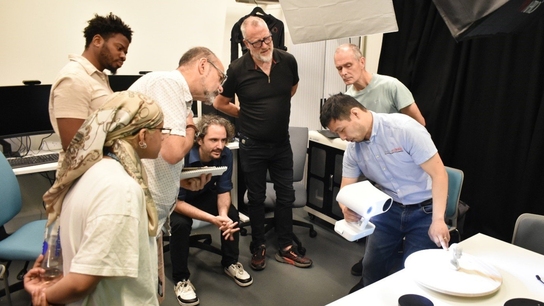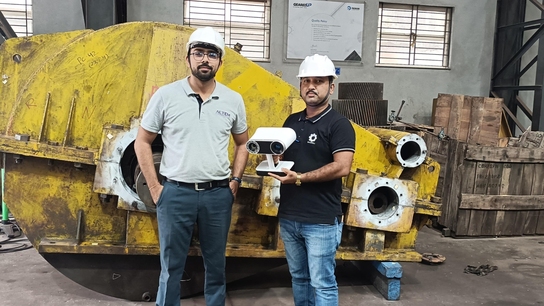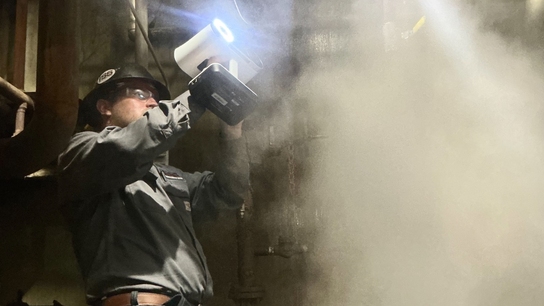Award-winning sculptor uses Artec 3D scanners to unleash his creativity and save hours on each project
The Goal: To use a handheld 3D scanner (Artec Eva/Artec Space Spider) to capture each maquette (model sculpture) digitally, then to create a precise and realistic 3D model of the small sculpture, which will be used to make the final sculpture.
Tools Used: Artec Eva, Artec Space Spider
Award-winning sculptor, Jamie Lester is breaking the mold – literally and figuratively. Known for a number projects, including the Brooklyn Wall of Remembrance at MCU Park and the Jerry West statue outside the WVU Coliseum, Jamie is a veteran sculptor, boasting over 20 years of experience.
Yet even with so much under the proverbial belt, Jamie recognizes the value of tapping into today’s powerful 3D imaging solutions in the creative process. He muses, “3D scanner is a flexible tool that helps me view the world in a whole new way. It unleashes new creativity into the work that I’ve been doing the same way for a very long time.”

However, it was only when Jamie fully realized the enormous potential of 3D scanning that he finally took the plunge and bought 3D imaging scanners Artec Eva and Space Spider from Artec reseller GoMeasure3D. Not to mention that it just made perfect sense in the context of sculpting.
No one will doubt that sculpting is physical in every way. The end result is a three-dimensional structure situated in a space invariably shared by viewers. Just the very imposing presence of a statue itself evokes a unique aesthetic effect that two-dimensional representational art can only mimic through tricks of perspective and vanishing points. As for sculptors, working and shaping clay over prolonged periods demand a tremendous amount of exertion.
For sculptors like Jamie, 3D solutions can help ease things a bit. And as Jamie’s example confirms, the transition from clay to bronze, design to installation is markedly faster with 3D scanning tools.
Jamie’s process starts off with gathering images and sketching designs of the statue. He then moves to 3D form by modeling a “maquette,” a small clay statue. This preparatory step enables him to tease out potential design problems in an already 3D context and find solutions to them early at the start. This maquette is also especially useful for clients, who can see what the final design will look like and give the green light.

If the client is satisfied with the design proposal, Jamie begins the labor-intensive part of the creative process – hand-sculpting the clay to the actual size of the statue.
If the client is satisfied with the design proposal, Jamie begins the labor-intensive part of the creative process – hand-sculpting the clay to the actual size of the statue. To illustrate the extent of this transformation, one of Jamie’s works was a bronze statue of the NBA legend Jerry West, which started out as a fifteen-inch tall maquette that Jamie had submitted to the reviewing committee. Twenty weeks and 1000 pounds of clay later, the tiny figure grew into a monumental clay statue that now stands in its bronze form at six feet six inches (minus its three-foot base).
Before applying clay, Jamie will need to build a so-called “armature.” This frame acts as the “skeleton” for the statue. Critical to this step is having proper measurements; the armature is after all the statue’s entire support structure. What used to be guesstimating for Jamie has now become precise measuring with Artec 3D scanners.
“Before we used to make the steel skeleton frame just by eyeballing the angles and measurements. Now, we take out the guesswork by using the Artec 3D scanner to scan the maquette into a 3D digital model. We get all the measurements we need to create the full physical 3D skeleton. We can now create the steel frame faster and with better accuracy,” he shares.

With the armature constructed, Jamie can begin spreading the clay over it, sculpting and revealing his artwork, which in turn becomes ever more lifelike with each manipulation.
With the armature constructed, Jamie can begin spreading the clay over it, sculpting and revealing his artwork, which in turn becomes ever more lifelike with each manipulation.
Once he finishes, he scans a model of the final clay sculpture to create a 3D digital replica. Artec 3D scanners can easily register data of complex geometries and fine textures, which make them excellent tools for sculptors. Thanks to their high level of precision and picture quality output, such details as brushes and markings caused by Jamie’s tools and fingers are all visible in the 3D images.
Jamie applauds this, “My sculptures are about 8 feet high. The Artec Eva and Space Spider are both very good at scanning large objects. They use geometry to register scans together rather than using photogrammetry. I don’t particularly like using photogrammetry stickers because I would need to buy them regularly – which can get quite expensive – and they mark up the surface.”
But Jamie saves not only on stickers. He also saves on materials and time.
“If I needed to make modifications to my clay sculptures previously, I would have to start from scratch because I use clay. Since purchasing the scanners, I can scan my sculptures digitally into 3D. I can then simply modify and do touch ups to my artwork in ZBrush before I send my final files to the foundry.”

With 3D scanning, this waste is avoided.
On top of this, Jamie was also able to eliminate a time-consuming and expensive step in the bronze casting process – producing a rubber mold. Before he started using Artec 3D scanners, rubber molds for his clay sculptures had to be fashioned. But, this process involved using harsh sealants that destroyed the clay. So once Jamie applied the sealant, he could no longer use the water-based clay again for other projects.
With 3D scanning, this waste is avoided.
“I use water clay as my medium of choice for hand sculpting. After scanning my sculptures, I can now reuse the clay after the project is complete. It’s not destroyed by the rubber sealant during the molding process.”
When you consider all work that Artec 3D scanners eliminate and all the resources saved or recycled thanks to 3D scanning, the benefits really stack up. As founder of Vandalia Bronze, Jamie highlights the amazing cost-cutting effects of integrating Artec 3D solutions:
“3D scanning saves us about $2,000 in labor cost per project by eliminating the need to create the mold in-house. There’s no shipping cost involved and it saves us time. It’s cheaper and more convenient for us to pay the foundry to do it than doing it ourselves.”
As an added bonus, Jamie relishes in the ability to keep an archive of his previous works.
As an added bonus, Jamie relishes in the ability to keep an archive of his previous works. “My sculptures would eventually dry up and crack. Before, I would have no records of the handmade sculptures I put countless hours into creating. Now, I can digitally archive my work electronically on the computer using the Artec 3D scanner.”
Of course, sculpting in a digital context wasn’t exactly an alien concept to the sculptor. Jamie recalls, “For the longest time, I wanted to focus on the digital aspect of sculpting by using ZBrush as part of my creative process. It wasn’t until I was exposed to 3D scanning that it motivated and inspired me to pursue it even further.”
And by all indications, Jamie doesn't seem set to stop now. He explains, “Using photographs (2D images) to explain my proposed monuments just don’t justify how it will look in the end. My sculptures are 3D. It just seems like a logical progression to show the reviewing committee and my clients my idea in 3D since it’s more intuitive and it’s easier to understand.”
Award-winning sculptor, Jamie Lester is breaking the mold – literally and figuratively.
Jamie has got plans now to use 3D scanning in order to create comprehensive visualizations to include not only the statue itself but also its surroundings. This means the statue can be seen in its final form and environment even before it’s made. The ability to project the interaction of an art object and its space in three dimensions well before anything is done is an advantage of the rarest kind, because it’s an advantage that very few before could possess – the advantage of foresight.
Scanners behind the story
Try out the world's leading handheld 3D scanners.





